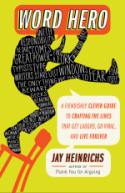Not to Mention a Muddled Mix of Metaphors
 Monday, February 27, 2006 at 08:55AM
Monday, February 27, 2006 at 08:55AM  Quote: “Torino’s Olympics, a topsy-turvy mix of marvels and misadventures…” USA Today
Quote: “Torino’s Olympics, a topsy-turvy mix of marvels and misadventures…” USA Today
Figure of Speech: alliteration, the figure of picked pickled peppers. Also known (among a very few rhetoricians) as paroemion (par OH mee on).
Why did Figaro wait to do this figure, after 148 entries ranging from accismus to yogiism? Well, for one thing, you presumably already know it. For another, alliteration is the clumsiest, laziest figure of all, and an unfortunate favorite of under-caffeinated headline writers.
The USA Today reporter, suffering from jet lag and over-hyped American athletes, resorts to alliteration (“mix of marvels and misadventures”) in a frantic attempt to warm up a chilly extravaganza that few Americans watched.
Snappy Answer: “Say that five times fast.”


Reader Comments (3)
but there are puns that give pleasure and pass as wit too. I believe that Hugh Blair approves of alliteration, why are you so grumpy about it, Figaro?
jen
Puns are something different: if they're done right, they sound a two-note cord allowing ironic oscillation (to coin an alliteration) between two meanings. Figaro is a big fan of puns, as his beleaguered children will tell you.
As for Hugh Blair, we believe he was partly responsible for rhetoric's downfall; he took it even farther from his political origins and helped smuggle it into belle lettres. Alliteration is one example; one rarely hears it in oral speech, outside of an occasional loopy vice president. (Remember Agnew's "Nattering nabobs of negativism"?)
Fig.
In speech, especially it can add to the strong rythm that the best speakers develop, used sparingly, it can add punch and drive to what might otherwise be a slow-moving passage. I think that especially paired with parallell structure it can be effective, if used carefully and sparingly (or should that be sparsely and sparingly?)